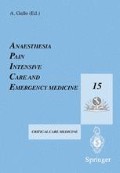Abstract
The incidence of acute renal failure (ARF) in hospitalized patients is 2–5% [1, 2]. For postoperative ARF an incidence of up to 30% has been described [3]. In the perioperative period renal dysfunction is more frequent in cardiac and vascular surgery [1, 3]. Also, the patient’s previous health status regarding renal, cardiovascular and pulmonary function influences the incidence and severity of renal dysfunction postoperatively [2]. As important as the patient’s history is the preoperative status (preoperative renal failure, cardiac failure). If the patient undergoes an emergency operation, the incidence of ARF becomes up to 10-fold higher in comparison to elective surgery [4, 5]. These patients often require support postoperatively in the intensive care unit (ICU). ARF develops in the ICU in up to 25% of patients [6, 7]. ARF in these patients is often part of Multiple-Organ-Dysfunction-Syndrome (MODS). The mortality increases with the number of organs failing. MODS alone has a mortality rate of up to 15% [6, 7]. If ARF is part of MODS then the mortality increases to over 50% [2]. Nevertheless, ARF has been independently associated with postoperative mortality [8]. If postoperative ARF occurs isolated, mortality is reported to be 10% [4].
Access this chapter
Tax calculation will be finalised at checkout
Purchases are for personal use only
Preview
Unable to display preview. Download preview PDF.
References
Kresse S, Schlee H, Deuber HJ et al (1999) Influence of renal replacement therapy on outcome of patients with acute renal failure. Kidney Int 56 (Suppl 72): 75–78
Corwin HL, Bonventre JV (1988) Acute renal failure in the intensive care unit. Part 1. Intensive Care Med 14: 10–16
Novis BK, Roizen MF, Aronson S et al (1994) Association of Preoperative Risk Factors with Postoperative Renal Failure. Anesth Analg 78: 143–149
Kellerman PS (1994) Perioperative Care of the Renal Patient. Arch Intern Med 154: 1674–1688
Urzua J, Lema G, Canessa R et al (1999) Renal Preservation in the Perioperative Period. Int Anesthesiol Clin 37 (2): 111–123
Mangano CM, Diamondstone LS, Ramsay JG et al (1998) Renal Dysfunction after Myocardial Revascularization: Risk Factors, Adverse Outcomes, and Hospital Resource Utilization. Ann Intern Med 128 (3): 194–203
Guerin C, Girard R, Selli JM et al (2000) Initial versus Delayed Acute Renal Failure in the Intensive Care Unit. A multicenter prospective epidemiological study. Am J Respir Crit Care Med 161 (3): 872–879
Bowen Fortescue E, Bates DW, Chertow GM (2000) Predicting acute renal failure after coronary bypass surgery: Cross-validation of two risk-stratification algorithms. Kidney Int 57: 2594–2602
Chertow GM, Lazarus JM, Christiansen CL et al (1997) Preoperative renal risk stratification. Circulation 95 (4): 878–884
Sural S, Sharma RK, Singhal M et al (2000) Etiology, prognosis and outcome of post-operative acute renal failure. Ren Fail 22 (l): 87–97
Chertow GM, Levy EM, Hammermeister KE et al (1998) Independent association between acute renal failure and mortality following cardiac surgery. Am J Med 104 (4): 343–348
Aronson S, Blumenthal R et al (1998) Perioperative Renal Dysfunction and Cardiovascular Anesthesia: Concerns and Controversies. J Cardiothorac Vase Anesth 12 (5): 567–586
Suen WS, Mok CK, Chiu SW et al (1998) Risk factors for development of acute renal failure (ARF) requiring dialysis in patients undergoing cardiac surgery. Angiology 49 (10): 789–800
Wan S, Leclerc JL, Vincent JL (1997) Cytokine responses to cardiopulmonary bypass: lessons learned from cardiac transplantation. Ann Thorac Surg 63 (l): 269–276
Badner NH, Murkin JM, Lok P (1992) Differences in Ph management and pulsatile/nonpul-satile perfusion during cardiopulmonary bypass do not influence renal function. Anesth Analg 75: 696–701
Valentine S, Barrowcliffe M, Peacock J (1993) A comparison of effects of fixed and tailored cardiopulmonary bypass flow rates on renal function. Anesth Intensiv Care 21: 304–308
Barrat J, Prajasingam R, Sayers RD et al (2000) Outcome of acute renal failure following surgical repair of ruptured abdominal aortic aneurysms. Eur J Endovasc Surg 20 (2): 163–168
Cao P, De Rango P (1999) Abdominal aortic aneurysms: current management. Cardiologia 44 (8): 711–7
Godet G, Fleron MH, Vicaut E et al (1997) Risk factors for acute postoperative renal failure in thoracic or thoracoabdominal aortic surgery: a prospective study. Anesth Analg 85 (6): 1227–1232
Perdue PW, Balser JL, Lipsett PA et al (1998) “Renal Dose” Dopamine in Surgical Patients. Ann Surg 227 (4): 470–473
Sirivella S, Gielchinsky I, Parsonnet V. (2000) Mannitol, furosemide, and dopamine infusion in postoperative renal failure complicating cardiac surgery. Ann Thorac Surg. 69 (2): 501–506
Lassnigg A, Donner E, Grubhofer G et al (2000) Lack of renoprotective effects of dopamine and furosemide during cardiac surgery. J AM Soc Nephrol 11 (1): 97–104
Bellomo R, Ronco C (1999) Continuous renal replacement therapy in the intensive care unit. Intensive Care Med 25: 781–789
Bellomo R, Ronco C (1998) Continuous versus intermittent renal replacement therapy in the intensive care unit. Kidney Int 53 (Suppl 66): 125–128
Liano F, Pascual J (1998) Outcomes in Acute Renal Failure. Sem Nephrol 8 (5): 541–550
Editor information
Editors and Affiliations
Rights and permissions
Copyright information
© 2001 Springer-Verlag Italia
About this paper
Cite this paper
Hein, O.V., Spies, C., Kox, W.J. (2001). Renal Dysfunction in the Perioperative Period. In: Gullo, A. (eds) Anaesthesia, Pain, Intensive Care and Emergency Medicine — A.P.I.C.E.. Springer, Milano. https://doi.org/10.1007/978-88-470-2903-3_28
Download citation
DOI: https://doi.org/10.1007/978-88-470-2903-3_28
Publisher Name: Springer, Milano
Print ISBN: 978-88-470-0136-7
Online ISBN: 978-88-470-2903-3
eBook Packages: Springer Book Archive

